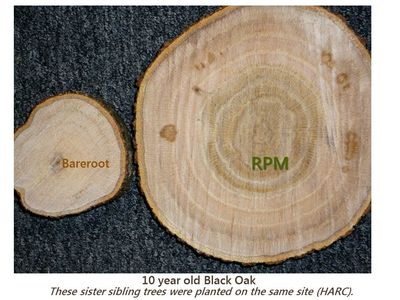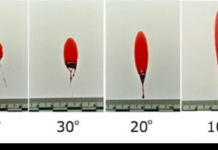Research conducted on a technology that enhances the root system of a plant finds that it allows the plant to grow up to three times as fast as any average plant. The Root Production Method (RPM) process gives plants the capability of growing a larger root mass in a shorter period of time, said Wayne Lovelace, C.E.O. of Forrest Keeling Nursery in Elsberry, MO, and developer of the system.
“This technology basically allows for a stronger root mass in a shorter period of time,” said Lovelace. “This eventually leads to faster growth, and a 90-95% survivability rate, compared to average bare-root plants.” ![RPM [left] vs normal bare root. Which looks better to you? Credit: Forrest Keeling Nursery.](http://www.scijourner.org/wp-content/uploads/2012/11/rpm.jpg)
“These trees, having an accelerated growth without genetic modification, have the potential for absorbing much more carbon than average trees,” said Gene Garrett, head of the University of Missouri in Columbia Agroforestry Center, who conducted a study in 2011 for Winrock, a corporation studying the effects of carbon sequestration in RPM-grown trees. Measurements of height, diameter at breast height, and age, were taken from exactly 1,000 RPM-grown trees from the RPM seed orchard, a few miles north of Elsberry, MO. The research concluded that RPM-grown trees can sequester, or store, up to three times more carbon than average trees not grown on the RPM system.
According to Lovelace, the RPM system is composed of three applications that all lead to the enhanced root-mass of a plant. The first is a 12-step air-pruning process. During this process, the taproot of a plant is exposed to air, and eventually dies off. Then, several lateral roots take the place of the single taproot.
The next application to the RPM process is the bacterial fungi mycorrhizae. Mycorrhizae is a symbiotic fungi that helps the root system of a plant absorb the nutrients of a plant.
The third application of the RPM process is the soil-less media found in the containers of the plants. Pine bark, rice hulls, sand, and a wetting agent, are all used in place of soil. This allows more airspace in the container, said Lovelace, which allows for the development of a larger root system.
The RPM process was first applied to restore bottomland forests that were being destroyed by floodwaters of the Mississippi River in 1993. The U.S. Army Corps of Engineers, Missouri Department of Conservation, and U.S. Fish and Wildlife, along with Lovelace, developed a planting scheme of RPM-grown oak trees that would help retain soil, and preserve the bottomland forests that are critical to the ecosystem.
Cornell University’s College of Agriculture and Life Sciences recently worked with the RPM process to develop the Super Sweet Sugar Maple. The new Super Sweet grows three times as fast as an average maple, and provides sap that could be boiled down into syrup, say Cornell scientists. The RPM system produced significantly larger Super Sweets in a short amount of time. Currently, Cornell’s College of Agriculture and Life Sciences is conducting a study on the benefits of the Super Sweet in regards to syrup production and quality.
“There is much work to be done”, said Lovelace. “The system itself has been modified very carefully in order to ensure the best results from the plants. Although we have had significant success with the RPM process here at home, the expansion of the RPM process is definitely an attainable goal.” 
To date, the RPM process awaits patents in roughly 60 countries. Troy Wiseman, chairman of EcoPlanet Bamboo, a business that promotes the use of bamboo in several different applications, said that he observed good results in his bamboo crop after the RPM process was applied to a few hundred bamboo plants on a plantation in South Africa.
“The RPM system has characteristics which, to me, promote themselves as being highly beneficial,” said Wiseman. “The results with the bamboo in South Africa were significant, and I look forward to the many advantages the RPM system has to offer.”
“The key to the RPM process is the fact that people are given the capability to use more with less,” said Lovelace. “One tree can go a long way. And trees are essential to all life on earth. If you plant one, or plant a thousand, you’re helping the planet.” Bo Young

This work is licensed under a Creative Commons Attribution-NonCommercial-NoDerivs 3.0 Unported License














so rpm is better for growing plants great to know